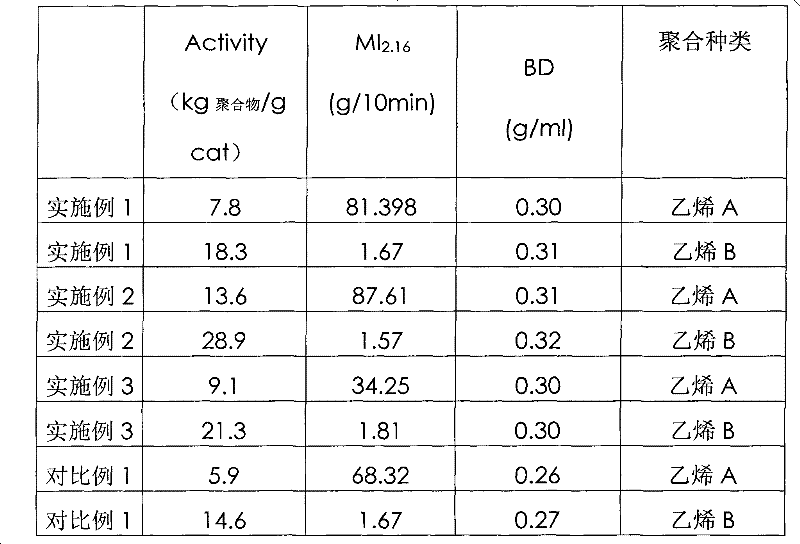Catalyst component for olefin polymerization, and preparation method thereof
An olefin polymerization and catalyst technology, applied in the field of catalyst components and catalysts, can solve the problems of difficult control, high material prices, and difficulty in controlling the shape of catalyst particles.
- Summary
- Abstract
- Description
- Claims
- Application Information
AI Technical Summary
Problems solved by technology
Method used
Image
Examples
Embodiment 1
[0045] Take 30ml of hexane, 3.15ml of dibutylmagnesium hexane solution (1M) and 1.0ml of isooctyl alcohol in turn, heat up to 50℃ and keep stirring for half an hour to obtain a transparent solution, then add polybutadiene block polyethylene oxide Alkyl copolymer (polybutadiene content 75wt%) hexane solution (10g / L) 2ml, lower the temperature to -50°C, add 0.6ml of phosphorus trichloride and 0.35ml of titanium tetrachloride in turn, after the addition, The temperature was rapidly increased to 50°C within 10 minutes, and the reaction was maintained for 2 hours. The temperature of the catalyst suspension was lowered to room temperature, allowed to stand, settled, and washed with hexane three times. The amount of hexane used was 50 ml each time. After the washing was completed, it was dried to obtain a brown solid fluid powder with an average particle size of 15.7 microns.
[0046] Elemental analysis (ICP): Ti: 9.35% (weight), Mg: 13.14% (weight).
[0047] Ethylene polymerization eval...
Embodiment 2
[0050] Add 2ml of hexane solution (10g / L) of polybutadiene block polyethylene oxide copolymer (polybutadiene content 75% by weight) during the catalyst preparation process, instead of adding polybutadiene block polyethylene oxide copolymer (Polybutadiene content 75wt%) hexane solution (10g / L) 6ml, and at the same time change 0.6ml of phosphorus trichloride to 0.6ml of phosphorus oxychloride, other conditions are the same as in Example 1, the average particle size It is 7.56 microns.
[0051] Elemental analysis (ICP): Ti: 11.37% (weight), Mg: 13.24% (weight).
[0052] The evaluation conditions of the catalyst for ethylene slurry polymerization were the same as in Example 1, and the polymerization results are shown in Table 1.
Embodiment 3
[0054] Change the 1.0ml isooctyl alcohol in the catalyst preparation process to 3.0ml isooctyl alcohol, quickly raise the temperature to 50°C within 10 minutes, change it to naturally and slowly raise the temperature to room temperature, and then heat to 50°C. Other conditions are the same as in Example 1. Its average particle size is 14.6 microns.
[0055] Elemental analysis (ICP): Ti: 10.75% (weight), Mg: 14.18% (weight).
[0056] The evaluation conditions of the catalyst for ethylene slurry polymerization were the same as in Example 1, and the polymerization results are shown in Table 1.
PUM
| Property | Measurement | Unit |
|---|---|---|
| boiling point | aaaaa | aaaaa |
| particle size | aaaaa | aaaaa |
Abstract
Description
Claims
Application Information
 Login to View More
Login to View More - R&D Engineer
- R&D Manager
- IP Professional
- Industry Leading Data Capabilities
- Powerful AI technology
- Patent DNA Extraction
Browse by: Latest US Patents, China's latest patents, Technical Efficacy Thesaurus, Application Domain, Technology Topic, Popular Technical Reports.
© 2024 PatSnap. All rights reserved.Legal|Privacy policy|Modern Slavery Act Transparency Statement|Sitemap|About US| Contact US: help@patsnap.com








